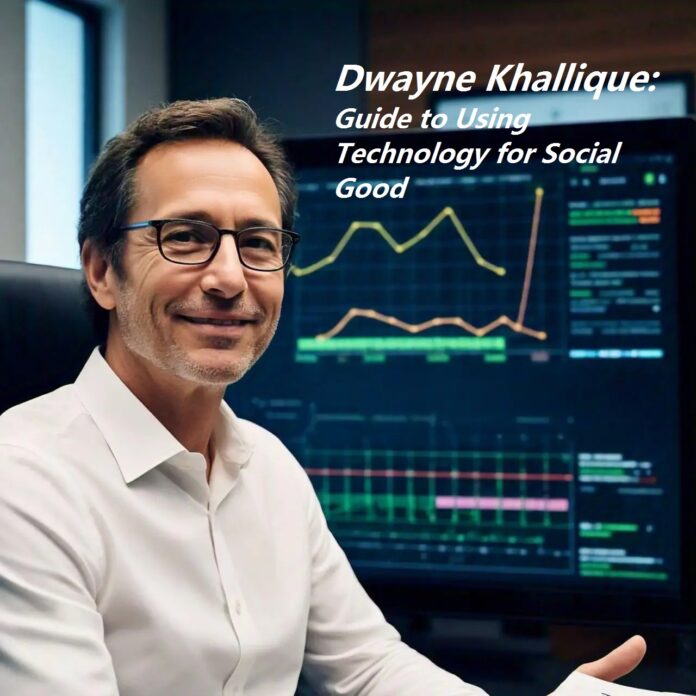Dwayne Khallique – We live in a time where the advancement of technology has progressed greatly, and with this advancement comes the opportunity to use it to solve societal problems. Tools ranging from artificial intelligence to blockchain are changing the way individuals, organisations, and governments deal with issues like poverty and climate change. Dwayne Khallique, a technology innovator and social change activist, has been leading the charge in the ever-evolving need to utilise technologies for the betterment of society.
In this article, I delve into his thoughts on how technology can be utilised in a positive manner, along with practical examples to work towards real-world change.
Understanding Social Good Technologies
Applying technological innovations that can solve issues within society, enhance the welfare of the community, and ensure equal opportunity development is referred to as technology for social good. These principles outline that technology is not an end goal by itself. The impact technology can bring towards an individual or a community is what matters. Dwayne Khallique firmly supports the idea of ethical change through technology and explains the necessity and efficacy of coupling advancements to ethics.
Key Areas Where Technology Drives Social Good
1. Education
Indeed, technology through e-learning resources is making learning enable with platforms and resources readily available. E-learners and teachers alike are now able to connect through the world thanks to virtual classroom technology and open educational resources; for instance, applications such as Khan Academy and Coursera provide students with access to relatively cheap courses and aid in seamless student-to-teacher interaction enabling quality education.
2. Healthcare
The Telemedicine Model itself accommodates medical professionals being able to conduct remote consultations with patients, which will inevitably increase the reach of healthcare in areas that are underdeveloped or lack adequate medical care. Furthermore, the incorporation of AI technology to medical diagnostics has significantly contributed to the enhancement in healthcare provision whereby people can now rely on wearable gadgets and mobile health applications for health assessment.
3. Environmental Sustainability
With the focus on reducing global warming and encouraging eco-friendliness, renewable energy including solar and wind has enabled a shift away from being dependent on fossil fuel. Smart electricity networks integrated with IoT solutions have optimized the consumption of energy, ensuring that there is minimal wastage, alongside applications that aim to reduce food wastage such as Too Good To Go.
4. Economic Empowerment
FinTech is introducing and empowering businesses and individuals that have been historically denied access to banking services. Blockchain systems, microfinance, and mobile payment applications enable small businesses and individuals with the financial stimuli that is essential for their growth and stability.
5. Disaster Response and Humanitarian Aid
Aid is delivered by drones to inaccessible locations while resource allocation in humanitarian response is made faster with the help of data analytics. Khallique, Dwayne, is quoted by drones and social media as giving aid to builders for humanitarian purposes during overcoming natural disasters.
Dwayne Khallique’s Principles for Leveraging Technology for Social Good
1. Socialisation
By engaging in information communication it is quite clear what is expected from this engagement.
2. Adjustment for the Collective
It is very relevant to ensure that the use of technology advances global equity regardless of wealth level, region, or disabilities that one may be residing. In order to achieve this, Khallique aims to reach the once discrete hierarchical distributor.
3. Online Rape Jokes
The use of technology entails ethical considerations as failing to wake a good truth is harmful to trust and accountability in technology. Efforts like determining malfunctioning causes are undertaken by Kosher Barley’s Principles. For example, AI algorithms should be developed that fit societal norms while being able to operate optimally to reduce instances and tendencies of inequality.
4. Joint Efforts and Stakeholders
In most cases, innovation requires joint work across industries. This makes a case for the value of public-private partnerships, NGOs, and community engagement in optimising the use of resources and expertise.
Individual and Organisational Actionable Steps
1. Educate Yourself
Familiarisation with the latest technological innovations and how they can be used for social benefit is extremely important. Go out and give webinars, read papers, and engage in conversations around new opportunities out there.
2. Develop Strategic Partnerships
For individuals, learning new technologies can help them engage usefully in social good work. For organisations, running training workshops helps staff members to be able to make use of the technology appropriately.
3. Apply Your Knowledge and Skills to Technology for Social Good Initiatives
Take part in or donate to technology-related social good initiatives. This includes the development of open source software for non-profit organisations as well as funding social entrepreneurship ventures.
4. Encourage Change in Regulation
Support legislation that guarantees equal opportunity to access technology. It should be noted that governments are important actors in creating the environment within which technology-based social initiatives operate through the provision of capital, legislation, and even policies.
5. Evaluate the Effectiveness
Develop systems that would ensure that there are measures of impact for technology-based initiatives. Such insights allow managers to better adapt their strategies to ensure that their initiatives contribute to intended results.
Real-World Examples
• M-Pesa
M-Pesa, through its affordable banking service, has been able to enhance financial inclusion in Kenya, giving previously unbanked people the opportunity to open accounts and transact.
• Duolingo
This language learning application is free to download and features a selection of teaching courses that cover a variety of different languages, as well as employing gamification and AI to help broaden the scope of education to everyone across the globe.
• Google’s Project Loon
The ongoing issue of digital exclusion was further addressed through this initiative, which intended to expand the possibilities of the World Wide Web to unreachable regions via high-technology balloons.
• Code.org
Wanting to increase the enrolment in computer science courses, Code.org offers tools that assist students and teachers from sectors that are historically underserved.
Challenges and Opportunities
Nevertheless, there are challenges, such as a lack of resources, inertia to change, and unintended consequences, which must be coped with. The Guidebook author Dwayne Khallique also believes that these challenges should be approached as opportunities for innovation and cooperation in his opinion.
Conclusion
Dwayne Khallique’s comments and suggestions demonstrate the social good technology has the power to bring about as long as it is properly aligned with the changes in the technology that is used and the collaborative efforts of people and organisations to define the right boundaries. The amendments that are made are limited only by one’s imagination, be it in education, medicine, environment, or economics. The limits are endless.
FAQs About Dwayne Khallique
Q1. Who is Dwayne Khallique?
A: Dwayne Khallique is a technology integration expert with a strong passion for making positive change to society using technology. He believes in the use of technology for more than just business profits.
Q2. What is technology for social good?
A: Technology for social good is the use of innovative technology to solve issues that affect human beings, improve living standards, and ensure fair opportunities for everyone.
Q3. How can technology improve education?
A: Technology such as e-Learning sites, virtual classes, and other online resources goes a long way in improving education by making important material available even to those in underserved communities.
Q4. What are examples of technology driving social good?
A: Examples of these include M-Pesa, Duolingo, and Google’s Project Loon technology which strive to enable people to leverage their expertise no matter how poor or remote they are.
Q5. What are the challenges of using technology for social good?
A: Some of the challenges of technology for social good are lack of proper resources, inability to embrace change, and ethical issues. Solutions to such problems include creativity, partnerships and engaging the communities.
Q6. In what ways can people help achieve the goals of social good using technology?
A: People can help by keeping themselves up to date with news, upgrading their computer literacy, joining volunteer projects, advocating for changes within the industry and championing digital equity.
Q7. Why should the technology field also focus on ethics?
A: Ethics ensures that there is full disclosure, data protection, and an element of responsibility, ensuring that no harm is caused and trust is built in the technology offered.
Q8. What kind of tools can be used to measure the effectiveness of the technology-based organisational efforts?
A: Organisations can apply the use of data analysis, use of questionnaires and feedback approaches to support the evaluation of how fruitful the organisation’s initiatives were so as to improve future approaches.


